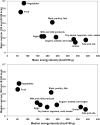The cost of US foods as related to their nutritive value
- PMID: 20720258
- PMCID: PMC2954450
- DOI: 10.3945/ajcn.2010.29300
The cost of US foods as related to their nutritive value
Abstract
Background: Comparisons of the cost of different foods relative to their energy and nutritive value were conducted in the 1800s by the US Department of Agriculture (USDA).
Objective: The objective was to reestablish the relations between food cost, energy, and nutrients by using contemporary nutrient composition and food prices data from the USDA.
Design: The USDA Food and Nutrient Database for Dietary Studies 1.0 (FNDDS 1.0) and the Center for Nutrition Policy and Promotion food prices database were used for analysis. For 1387 foods, key variables were as follows: energy density (kcal/g), serving size (g), unit price ($/100 g), serving price ($/serving), and energy cost ($/kcal). A regression model tested associations between nutrients and unit price ($/100 g). Comparisons between food groups were tested by using one-factor analyses of variance. Relations between energy density and price within food groups were tested by using Spearman's correlations.
Results: Grains and fats food groups supplied the lowest-cost dietary energy. The energy cost for vegetables was higher than that for any other food group except for fruit. Serving sizes increased with water content and varied inversely with energy density of foods. The highest prices per serving were for meats, poultry, and fish, and the lowest prices per serving were for the fats category. Although carbohydrates, sugar, and fat were associated with lower price per 100 g, protein, fiber, vitamins, and minerals were associated with higher price per 100 g, after adjustment for energy.
Conclusions: Grains and sugars food groups were cheaper than vegetables and fruit per calorie and were cheaper than fruit per serving. These price differentials may help to explain why low-cost, energy-dense foods that are nutrient poor are associated with lower education and incomes.
Figures




Comment in
-
Food costs and healthful diets: the need for solution-oriented research and policies.Am J Clin Nutr. 2010 Nov;92(5):1007-8. doi: 10.3945/ajcn.110.002717. Epub 2010 Sep 29. Am J Clin Nutr. 2010. PMID: 20881063 No abstract available.
-
Energy-adjusted food costs make little economic sense.Am J Clin Nutr. 2011 Apr;93(4):861; author reply 862-3. doi: 10.3945/ajcn.110.009639. Epub 2011 Jan 26. Am J Clin Nutr. 2011. PMID: 21270375 No abstract available.
-
Fundamental misunderstanding of the relation between energy density (kcal/g) and energy cost ($/kcal).Am J Clin Nutr. 2011 Apr;93(4):867-8; author reply 868-9. doi: 10.3945/ajcn.110.011072. Epub 2011 Feb 16. Am J Clin Nutr. 2011. PMID: 21325439 Free PMC article. No abstract available.
References
-
- Atwater WO. Foods: nutritive value and cost. Washington, DC: Government Printing Office, 1894. (USDA Farmers Bulletin No. 23.)
-
- Lipsky LM. Are energy dense foods really cheaper? Reexamining the relation between food price and energy density. Am J Clin Nutr 2009;90:1397–401 - PubMed
-
- Frazao E. Less-energy-dense diets of low income women in California are associated with higher energy adjusted costs but not with higher daily diet costs. Am J Clin Nutr 2009;90:701. - PubMed
-
- Milner RD. The cost of food as related to its nutritive value. Agriculture Yearbook 1902, pp. 387–406. National Agricultural Library Digital Repository. Available from: http://naldr.nal.usda.gov/exe/zynet.exe/YOA190204330387.xml (cited 24 July 2010)
-
- Darmon N, Briend A, Drewnowski A. Energy dense diets are associated with lower diet costs: a community study of French adults. Public Health Nutr 2004;7:21–7 - PubMed
Publication types
MeSH terms
Substances
Grants and funding
LinkOut - more resources
Full Text Sources
Medical

